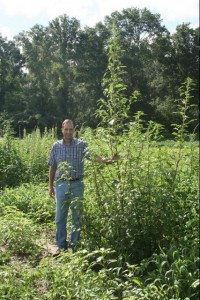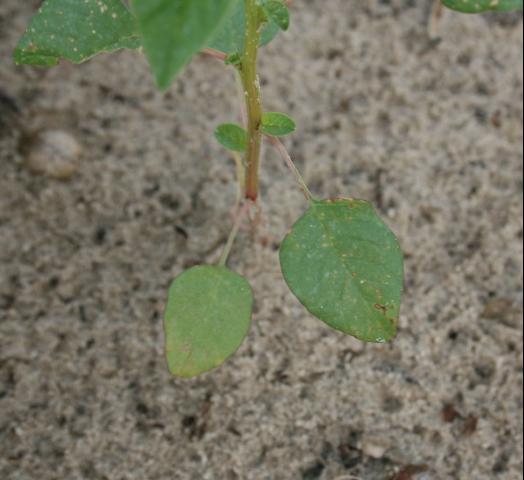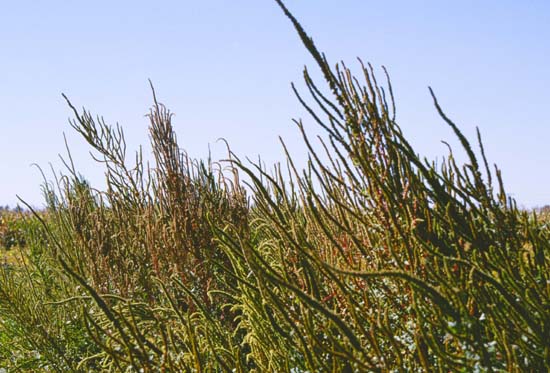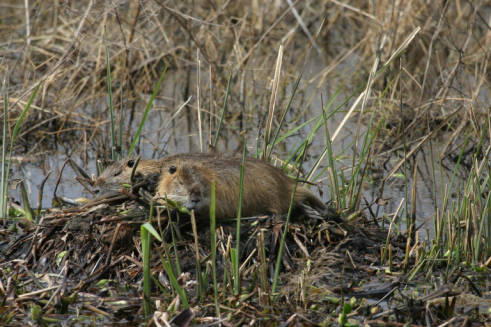by | Jan 3, 2014

Palmer amaranth can reach heights up 10 feet and signal real trouble for hunters, farmers, and land managers. Loaded with numerous small seeds, mature plants and “offspring” are difficult to control. Photo Courtesy of University of Florida / IFAS
Deer feeders are common in North Florida, and “deer corn” is sold in multiple markets. Cross-roads convenience stores sell it in plain brown bags and big box stores in town sell it in camouflage bags with three color pictures of giant bucks on the front. With the high price of corn in 2012, many hunters saved a few dollars buying “combine run” corn from local farmers or corn screenings from grain elevators. The corn’s no different, however, either product can contain weed seed, especially Palmer amaranth. These weeds can mean big trouble for farmers and hunters.
Palmer amaranth is a species of pig weed, but it’s not your granddaddy’s “careless weed”. It’s taller than either red root pigweed or spiny pigweed, and is becoming resistant to several herbicides, most notably glyphosate (“Roundup”). Amaranth seed are small and plentiful (1 to 1.5 millimeters in diameter) and easily can fit in the nooks and crannies of grain harvesting and handling equipment.

Palmer amaranth first true leaves have small notches on the end and can serve as an identifying characteristic. Photo Courtesy of University of Florida / IFAS.
Once Palmer amaranth seed make it into a deer feeder, there’s a huge opportunity for seedlings to take root in places under the radar of typical scouting and control measures. If these seedlings are herbicide resistant, you’ve done far more harm to the landowner than any savings on corn cost can offset. Conservative estimates indicate herbicide costs have at least doubled due to herbicide resistant weeds. Do your local farmer a real favor; scout and control weeds coming from your deer feeder.
Further information on identifying and controlling Palmer amaranth is available from your county Extension agent or at http://edis.ifas.ufl.edu/ag346
Feeding corn to deer and turkey is permitted by the Florida Fish and Wildlife Conservation Commission as long as the following restrictions are met. “Resident game and wild hogs may be hunted in proximity of year-round game-feeding stations on private lands, provided the feeding station has been maintained with feed for at least six months prior to taking resident game,” and “Wild turkey may not be taken if the hunter is less than 100 yards from a game feeding station when feed is present.” See General Information regarding Feeding Game at http://myfwc.com/hunting/regulations/general-information
by Brooke Saari | Mar 10, 2013
National Invasive Species Awareness Week: March 3rd – March 8th
March 10th: Palmer Amaranth (Palmer amaranth) & Nutria (Myocastor coypus):

Image courtesy of University of Illinois Extension
Palmer Amaranth: Palmer Amaranth, a type of pigweed, is invading the Southeast. It is a very troublesome weed for us because it is fast growing, produces a lot of seed and easily develops herbicide resistance. Palmer is a summer annual weed that can grow up to 10 feet tall. Each female plant can produce up to 500,000 seeds. Populations of this weed have developed resistance to 4 different classes of herbicides, including glyphosate or “Round-Up”. There are other types of pigweed in Florida, such as spiny and redroot pigweed, so you must be able to positively distinguish Palmer Amaranth from others.
Here are the main differences:
1. Petioles (or stalks joining leaves to the stem) are as long or longer than the leaf blades.
2. The plant has long terminal inflorescence (cluster of flowers on top of the stem).
3. They have prominent white veins on the lower surface of the leaves.
4. They have hairless leaves.
5. They are faster growing than other pigweeds.
If you have identified palmer amaranth in your field, treat with glyphosate. If the pigweed survives, then quickly hand-weed the female plants as soon as possible. Even if just a few plants survive this year, next year you could have thousands more. Palmer Amaranth is very difficult to control but by employing sound IPM principles it can be managed. Refer to http://edis.ifas.ufl.edu/ag346 for identification and control measures.
For more information contact the author Jennifer Bearden, Agriculture Extension Agent, 850-689-5850.

Photo Courtesy of US Fish & Wildlife National Digital Library
Nutria: This large rodent resembles a beaver but has a round tail. They are originally from South America and were brought to the United States for the fur business. Nutria are completely vegetarian and feed on both land and aquatic plants. Their small forelimbs are used to dig out roots and rhizomes and they can eat their own weight in plants each day. Feeding occurs anytime but is most often at dawn and dusk. From their initial release in Louisiana they have spread all over the Gulf coast. There are reports of them in the Chesapeake Bay area, Ohio, and along the Oregon coast. They become sexually mature very quickly (4-9 months) and have a short gestation period (130 days). Breeding year around a single female can produce 2.5 litters each year so in a short period of time high numbers of nutria can completely clear a densely vegetated area. Another problem with them is their ability to burrow into dikes and levees, making them weaker. Their occurrence in Florida has been spotty, with 45 individuals being recorded. There are records in all Florida panhandle counties except Bay.
For more information, contact the author Rick O’Connor, Sea Grant/Marine Sciences Agent 850-475-5230.




